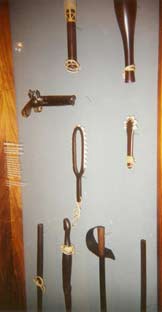
Hawaiian History
& Culture
Hawaiian
Tiki Gods
Ancient Hawaiian
Weapons Analysis
Ancient Hawaiian
Weapons and Tactics
The ancient Hawaiians developed a wide variety of effective weapons and warfare tactics yet their native material culture is considered Stone Age. (At the time of their ‘discovery' their only knowledge of metal was most likely from flotsam that washed up onto their shores.) The ancient Hawaiians skills in warfare might be more expected thought when you realize that despite not having any metal they had already developed taxation and world-class voyaging disciplines. The ancient Hawaiians used great ingenuity in dealing with the resources available. For spearheads they used heavy tropical wood, so heavy that it sinks. Sharks teeth were

The Weapons that
United Ancient Hawaii
utilized for making a slashing blade. They also developed the use of large crescent shaped formations of pike men, each warrior designated to a smaller squad. Ancient Hawaiian warriors also fought in squads on rougher terrain instead of combersom large crescent formations. Highly skilled warriors were used to attempt to break up these ranks with shorter weapons and protective feather cloaks. This seems to mirror ancient western arms development, without the use of metal. Specifically it reminds me of when the Romans used their legions equipped with large shields and spears to close and kill the pike men of the Macedonian phalanxes, who had defeated the tactics of the spear/shield wielding Greeks.
Why didn't the ancient Hawaiians use the bow?
The ancient Hawaiian warriors did have knowledge of the weapon, however they considered it a toy or for hunting. Slings ( Ma'a) were for war. The reason the sling was the ancient Hawaiian warriors main missile weapon are many. Slings offered an advantage in range; this was true of the ancient Western world as well. In the battle of Thermopoly the Greeks were able to hold the Persian archers at bay with the greater range of their slings. This has been documented in several sources throughout the ancient world. The sling persisted as the longest ranged hand weapon until the advent of the long bow. It had other advantages in that its ammunition was readily available; in fact the heavy volcanic stones of Hawaii were perfect for this purpose. Slings also have the advantage of being easily carried, a slinger could carry several back up weapons with them on campaigns. Another advantage is that slings are not as adversely effected by weather as the bow. Wind can effect the flight of an arrow significantly. While it still effects a sling stones flights, sling weapons are less effected by wind. Rain, which is common on the Hawaiian Islands, can have a severe effect on bowstrings rendering bows useless. Slings were eventually phased out in western warfare during the middle ages due to plate armor, while a sling could kill someone with leather armor with blunt force, plate armor could not be penetrated. The bow however could pierce armor and it required less training to use, hence it eclipsed the sling.
Paddles, Double Daggers, and Trip Weapons, Oh my!
Many weapons in the Hawaiian arsenal were unique and inventive. A paddle was a perfect weapon for an ancient Hawaiian marine. They could go straight from powering a war canoe to slashing or stabbing with their sharp pointed ends. Double daggers and trip weapons were unique to the Hawaiians and it must have been stunning to see a warrior incorporate these weapons in a battle. But how would the stunning array of ancient Hawaiian weapons fare against the European weapons of their time?
The weapons and equipment of ancient Hawaii were effective against the Europeans in that armor had already become in effective against guns so a fast army was ideal. Their powerful pikemen were still effective despite firearms, pikemen were even used in the US civil. Militarily the native Hawaiian warriors still held the upper hand against the Europeans due to their large numbers until the late 1800's. However, European weapons certainly accelerated an on going process of unification of the islands by war. The great chiefs obtained European weapons by any means possible in an arms race between the major kingdoms. In the final analysis European weapons my have changed history by breaking a stalemate or simply may have expediated a process of unification that had begun centuries before Captain Cooks arrival on Hawaii.
Regardless, European weapons certainly helped win battles. Kamehameha's use of cannons and muskets caused great panic and slaughter in the ranks of his enemies. However, Western weapons were available on both sides of these wars and it took 26 years for the first king, Kamehameha, to subdue his rivals. The battles were by no means scrimmages or local actions, but rather massive pitched battles.
According to Isabella L. Bird
A very interesting history begins with Kamehameha the Great, the Conqueror, or the Terrible; the “Napoleon of the Pacific,” as he has been called. He united an overmastering ambition to a singular gift of ruling, and without education, training, or the help of a single political precedent to guide him, animated not only by the lust of conquest, but by the desire to create a nationality, he subjugated every thing that his canoes could reach, and fused a rabble of savages and chieftaincies into a united nation, every individual of which to this day inherits something of the patriotism of the Conqueror.
His wars were by no means puny either in proportions or slaughter, as, for instance, when he meditated the conquest of Kauai, his expedition included seven thousand picked warriors, twenty-one schooners, forty swivels, six mortars, and an abundance of ammunition! His victories are celebrated in countless mêlés or unwritten songs, which are said to be marked by real poetic feeling and simplicity, and to resemble the Ossianic poems in majesty and melancholy. He founded the dynasty which for seventy years has stood as firmly, and exercised its functions for the welfare of the people on the whole as efficiently, as any other government.